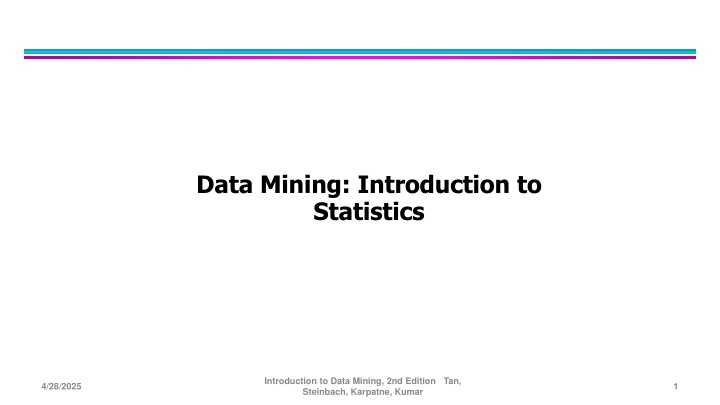
Introduction to Statistics and Data Mining Basics
Delve into the fundamentals of statistics and data mining with insights on central tendency measures, statistical calculations, and working with data outliers. Learn about mean, mode, median, and how to analyze data effectively. Explore how statistics work in formulating hypotheses and drawing conclusions from observations.
Download Presentation

Please find below an Image/Link to download the presentation.
The content on the website is provided AS IS for your information and personal use only. It may not be sold, licensed, or shared on other websites without obtaining consent from the author. If you encounter any issues during the download, it is possible that the publisher has removed the file from their server.
You are allowed to download the files provided on this website for personal or commercial use, subject to the condition that they are used lawfully. All files are the property of their respective owners.
The content on the website is provided AS IS for your information and personal use only. It may not be sold, licensed, or shared on other websites without obtaining consent from the author.
E N D
Presentation Transcript
Data Mining: Introduction to Statistics Introduction to Data Mining, 2nd Edition Tan, Steinbach, Karpatne, Kumar 4/28/2025 1
Statistics Introduction Introduction to Data Mining, 2nd Edition Tan, Steinbach, Karpatne, Kumar 4/28/2025 2 2
Statistics How Does it Work? How Statistics Works Formulatea Hypothesis - Smokingcauses cancer Make Observations - Get data regarding smoking habits and medical history Analyze Data and Make Conclusions - Accept or reject hypothesis Introduction to Data Mining, 2nd Edition Tan, Steinbach, Karpatne, Kumar 4/28/2025 3 3
Statistics Basic Statistical Measurements Introduction to Data Mining, 2nd Edition Tan, Steinbach, Karpatne, Kumar 4
Central Tendency Measures Mean, Mode, Median Introduction to Data Mining, 2nd Edition Tan, Steinbach, Karpatne, Kumar 8 4/28/2025
CentralTendency Measures Calculation Given the following dataset, let s calculate the mean, median and mode. 65 54 89 56 35 14 56 55 87 45 92 Mean ( 65 + 54 + 89 + 56 + 35 + 14 + 56 + 55 + 87 + 45 +92 ) / 11 = 58.9 Median 14 35 45 54 55 56 56 65 87 89 92 56 mode Given that 56 is the only repeated value, it's clearly also the mode. Introduction to Data Mining, 2nd Edition Tan, Steinbach, Karpatne, Kumar 9 4/28/2025
CentralTendency Measures Mean If you use a mean to analyze your data, you will notice that it is quite sensitive to outliers. Outliers can affect the value of the mean. When utilizing a mean, you can limit the effects of outlier data by trimming and winorizing the mean. Let's use this data and see how the mean changes between a normal mean, trimmed mean, and winsorized mean. Data: 1, 2, 2, 3, 3, 4, 4, 4, 5, 20 You will notice that this data has an outlier of 20, which is much larger than the rest of the data. Introduction to Data Mining, 2nd Edition Tan, Steinbach, Karpatne, Kumar 10 4/28/2025
Central Tendency Measures Mode for Categorical Data The mode is typically used with qualitative information to identify the most frequent class, as shown below. Introduction to Data Mining, 2nd Edition Tan, Steinbach, Karpatne, Kumar 11 4/28/2025
Measures of Variability Range Range = Highest value Lowest value Introduction to Data Mining, 2nd Edition Tan, Steinbach, Karpatne, Kumar 13 4/28/2025
Measures of Variability Interquartile Range Range Interquartile Range Introduction to Data Mining, 2nd Edition Tan, Steinbach, Karpatne, Kumar 14 4/28/2025
Measures of Variability Interquartile Range Since the interquartile range is defined using quartiles, it is a preferred measure of variation when the median is used as a measure of centre (i.e. in case of skewed distribution, where the distribution is not normal). Introduction to Data Mining, 2nd Edition Tan, Steinbach, Karpatne, Kumar 15 4/28/2025
Measures of Variability Box Plot Interpretation Interpreting a boxplot can be done once you understand what the different lines mean on a box and whisker diagram. The line splitting the box in two represents the median value. This shows that 50% of the data lies on the left hand side of the median value and 50% lies on the right hand side. The left edge of the box represents the lower quartile; it shows the value at which the first 25% of the data falls up to. The right edge of the box shows the upper quartile; it shows that 25% of the data lies to the right of the upper quartile value. The values at which the horizontal lines stop at are the values of the upper and lower values of the data. The single points on the diagram show the outliers. Most of the distribution of data falls between the whiskers. Introduction to Data Mining, 2nd Edition Tan, Steinbach, Karpatne, Kumar 17 4/28/2025
Measures of Variability Outliers Introduction to Data Mining, 2nd Edition Tan, Steinbach, Karpatne, Kumar 20 4/28/2025
Measures of Variability Outliers Example Introduction to Data Mining, 2nd Edition Tan, Steinbach, Karpatne, Kumar 21 4/28/2025
Measures of Distribution Histogram Normal Distribution Distribution Skewness Kurtosis 25 4/28/2025
Measures of Distribution Histograms Uncle Bruno owns a garden with 30 black cherry trees. Each tree is of a different height. The height of the trees (in inches): 61, 63, 64, 66, 68, 69, 71, 71.5, 72, 72.5, 73, 73.5, 74, 74.5, 76, 76.2, 76.5, 77, 77.5, 78, 78.5, 79, 79.2, 80, 81, 82, 83, 84, 85, 87. We can group the data as follows in a frequency distribution table by setting a range: Introduction to Data Mining, 2nd Edition Tan, Steinbach, Karpatne, Kumar 26 4/28/2025
Measures of Distribution Skewness Introduction to Data Mining, 2nd Edition Tan, Steinbach, Karpatne, Kumar 28 4/28/2025
Measures of Distribution Kurtosis Introduction to Data Mining, 2nd Edition Tan, Steinbach, Karpatne, Kumar 29 4/28/2025
Measures of Distribution Normal Distribution Introduction to Data Mining, 2nd Edition Tan, Steinbach, Karpatne, Kumar 30 4/28/2025
